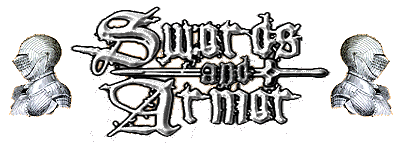
Have you ever been to an armor website and wondered "what
in the world is a lorica segmentata ",
or looked for the history of it and never found anything? Well, look no further,
we are here to tell you everything you could possibly want to know about the
lorica segmentata roman armor.
The lorica segmentata was a type of armor used primarily
in the Roman Empire at the end of the 1st century B.C. and continuing until
the middle of the 3rd century A.D. The first reconcilable fragments of the lorica
segmentata were discovered at Bad Deutch Altenburg in Austria (the legionary
base of Carnuntum) in 1899. However, it wasn't until the discovery of the Corbridge
Hoard-a wooden box containing 12 sections (six shoulder and six torso, none
of them matching) at Corbridge in 1964 that it was possible to interpret it
without the help of sculptural evidence. Thanks to painstaking reconstruction
of the rusty fragments by archaeologist Charles Daniels it was possible for
H Russell Robinson of the Tower Armouries to make the first working replica.
Order Our Lorica Segmentata Roman Armor Online
Lorica Segmantata Armor
Roman Armor and Swords Roman Armor Home Helmets
Armor Wearable Armor Medieval swords
With such a strange name, one couldn't help but wonder
where the lorica segmentata got its name. It was best known from the spiral
reliefs on Trojans Column in Rome and it was sculptures of this type that first
led scholars to study it. In order for scholars to study this piece, they had
to think of a name for it. Since most scholars at that time wrote in Latin,
they decided on the phrase (armor in pieces).
This Latin name was first used in the 16th century. It is still referred to
by that name but you may also find it described as segmental, articulated, plate
armor, or even Schienenpanzer.
This particular armor was made up of four sections: two for shoulders and two
for torso. The Lorica Segmentata armor itself consists of broad ferrous
(iron or steel) strips fastened to internal leather straps. The strips were
arranged horizontally on the body, overlapping downwards, and they surrounded
the torso in two halves, being fastened at the front and back. The upper body
and shoulders were protected by additional strips
(shoulder guards)
and breast and back plates. This form of armor allowed it to be stored very
compactly since it could be separated into four sections. The main concern with
this type of armor was its complexity leaving it vulnerable to attrition and
corrosion.
Around the time of Emperor Tiberius (A.D. 14-37), lorica segmentata began
to replace the older lorica hamata (mail cuirass) in many legionary formations.
This new armor was generally considered to be superior to the lorica hamata
because of it's greater flexibility, lighter weight, and its comparative ease
to manufacture. It is believed that only legionaries (heavy infantry of the
Roman legions) were issued with the armor. After Commodus (Marcus Aurelius's
son and successor) died, the empire erupted into civil war, eventually won by
Septimus Severus. These wars of succession (193 A.D.-197 A.D.) can be viewed
as the last gasp of the armor. It was no longer a necessity to new recruits
and had already become a very rare sight although similar armoring techniques
were still used during the 16th century, employing sliding rivets and this was
known as Anima.
shields SCA Civil War History of Knights
Policies fantasy weapons Scottish Samurai
copyright © swordsandarmor.com